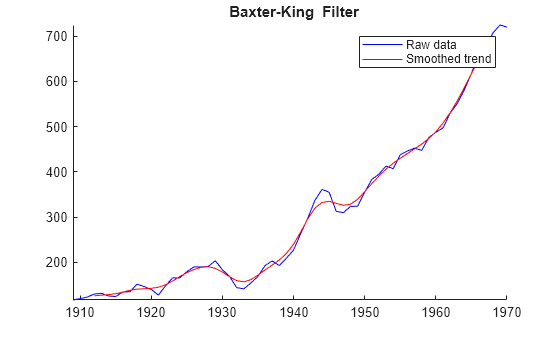Apply the Baxter-King filter to all variables in input table variables.
Load the Schwert stock data set Data_SchwertStock.mat, which contains monthly returns of the NYSE index from 1871 through 2008 in DataTimeTableMth, among three other variables (for details, enter Description). Remove all missing observations from all series.
Aggregate the monthly data in the timetable to quarterly measurements.
Apply the Baxter-King filter to all variables in the quarterly timetable. Use the default cutoffs and lag length for the moving average.
TQTT and CQTT are 220-by-4 timetables containing the trend and cyclical components, respectively, of the series in TTQ. Variables in the input and output timetables correspond. By default, bkfilter filters all variables in the input table or timetable. To select a subset of variables, set the DataVariables option.
The default lag length is 12. Consequently, the first and last 12 rows in the output timetable are NaN-valued.
Remove the leading and lagging NaNs from the trends and display what remains.
TQTTCut=196×4 timetable
Time Return DivYld CapGain CapGainA
___________ __________ _________ __________ __________
31-Mar-1874 -0.039822 0.0032538 -0.028711 -0.043076
30-Jun-1874 -0.017105 0.0044321 -0.023919 -0.021537
30-Sep-1874 0.0039487 0.0010179 0.002954 0.0029307
31-Dec-1874 -0.0078419 0.0050448 -0.0063275 -0.012887
31-Mar-1875 0.020326 0.0024432 0.015128 0.017883
30-Jun-1875 -0.0020712 0.0038703 -0.017158 -0.0059416
30-Sep-1875 -0.0085514 0.0044146 -0.01171 -0.012966
31-Dec-1875 -0.006103 0.0036185 -0.0058395 -0.0097214
31-Mar-1876 -0.0055681 0.0031237 -0.0059341 -0.0086918
30-Jun-1876 0.013271 0.0044001 0.0034571 0.0088705
30-Sep-1876 -0.033603 0.0042907 -0.03317 -0.037894
31-Dec-1876 0.04053 0.0045942 0.031644 0.035936
31-Mar-1877 0.0023469 0.0032843 -0.014032 -0.0009374
30-Jun-1877 -0.061762 0.004893 -0.049214 -0.066655
30-Sep-1877 0.066959 0.0047892 0.058975 0.06217
31-Dec-1877 -0.017554 0.0029106 -0.026179 -0.020464
⋮
CQTTCut=196×4 timetable
Time Return DivYld CapGain CapGainA
___________ __________ ___________ __________ __________
31-Mar-1874 0.01699 -0.00117 0.015758 0.01816
30-Jun-1874 0.020025 -0.0013329 0.018379 0.021358
30-Sep-1874 0.016201 -0.00079002 0.013713 0.016991
31-Dec-1874 0.0064867 1.9907e-06 0.0036027 0.0064847
31-Mar-1875 -0.002434 0.00036989 -0.0041687 -0.0028039
30-Jun-1875 -0.0061591 3.1258e-05 -0.0050638 -0.0061903
30-Sep-1875 -0.0033857 -0.00076308 0.00044226 -0.0026226
31-Dec-1875 0.0015781 -0.0013475 0.0058395 0.0029255
31-Mar-1876 0.0017405 -0.0010938 0.0031869 0.0028343
30-Jun-1876 -0.0062558 1.9708e-05 -0.0094095 -0.0062755
30-Sep-1876 -0.021212 0.0013923 -0.026956 -0.022604
31-Dec-1876 -0.034671 0.0023024 -0.03854 -0.036974
31-Mar-1877 -0.039779 0.0023122 -0.038012 -0.042091
30-Jun-1877 -0.028847 0.0017301 -0.022516 -0.030577
30-Sep-1877 -0.003445 0.0011069 0.0022493 -0.0045519
31-Dec-1877 0.023547 0.00090623 0.022362 0.022641
⋮
To compare outputs between different tabular inputs, apply the Baxter-King filter to all variables in the table of monthly data DataTableMth and the timetable of monthly data TTM.
Return DivYld CapGain CapGainA
__________ _________ __________ __________
May1924 -0.0016302 0.002973 -0.0046032 -0.0046032
Jun1924 0.047692 0.0065778 0.041115 0.041115
Jul1924 0.044844 0.0060522 0.038792 0.038792
Aug1924 0.010929 0.0019358 0.0089936 0.0089936
Sep1924 -0.0086959 0.006971 -0.015667 -0.015667
Oct1924 -0.0014852 0.0049456 -0.0064308 -0.0064308
Nov1924 0.062927 0.0020931 0.060834 0.060834
Dec1924 0.045108 0.0070319 0.038076 0.038076
Return DivYld CapGain CapGainA
_________ ___________ _________ _________
May1924 0.0074662 -4.9042e-05 0.0075152 0.0075152
Jun1924 0.017044 0.00019971 0.016844 0.016844
Jul1924 0.016657 0.00028124 0.016376 0.016376
Aug1924 0.0096193 0.00019693 0.0094224 0.0094224
Sep1924 0.0035508 0.00014389 0.0034069 0.0034069
Oct1924 0.0064063 7.9476e-05 0.0063268 0.0063268
Nov1924 0.013666 7.2083e-05 0.013594 0.013594
Dec1924 0.015515 0.00010861 0.015407 0.015407
Time Return DivYld CapGain CapGainA
___________ __________ _________ __________ __________
01-May-1924 -0.0016302 0.002973 -0.0046032 -0.0046032
01-Jun-1924 0.047692 0.0065778 0.041115 0.041115
01-Jul-1924 0.044844 0.0060522 0.038792 0.038792
01-Aug-1924 0.010929 0.0019358 0.0089936 0.0089936
01-Sep-1924 -0.0086959 0.006971 -0.015667 -0.015667
01-Oct-1924 -0.0014852 0.0049456 -0.0064308 -0.0064308
01-Nov-1924 0.062927 0.0020931 0.060834 0.060834
01-Dec-1924 0.045108 0.0070319 0.038076 0.038076
Time Return DivYld CapGain CapGainA
___________ _________ ___________ _________ _________
01-May-1924 0.0074662 -4.9042e-05 0.0075152 0.0075152
01-Jun-1924 0.017044 0.00019971 0.016844 0.016844
01-Jul-1924 0.016657 0.00028124 0.016376 0.016376
01-Aug-1924 0.0096193 0.00019693 0.0094224 0.0094224
01-Sep-1924 0.0035508 0.00014389 0.0034069 0.0034069
01-Oct-1924 0.0064063 7.9476e-05 0.0063268 0.0063268
01-Nov-1924 0.013666 7.2083e-05 0.013594 0.013594
01-Dec-1924 0.015515 0.00010861 0.015407 0.015407
Because the data is disaggregated, the outputs of the daily data have more rows than from the quarterly data. The filter results of the daily inputs are equal among the corresponding outputs, but bkfilter returns tables of results, instead of timetables, when you supply data in a table.







